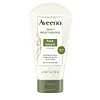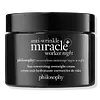What's inside
What's inside
 Key Ingredients
Key Ingredients

 Benefits
Benefits

 Concerns
Concerns

 Ingredients Side-by-side
Ingredients Side-by-side

Water
Skin ConditioningGlycerin
HumectantDicaprylyl Ether
EmollientStearic Acid
CleansingCaprylic/Capric Triglyceride
MaskingCetyl Alcohol
EmollientAvena Sativa Kernel Flour
AbrasiveCetearyl Alcohol
EmollientDimethicone
EmollientPhenoxyethanol
PreservativeCarbomer
Emulsion StabilisingCaprylyl Glycol
EmollientCeteareth-20
CleansingSodium Hydroxide
BufferingSodium Citrate
BufferingCitric Acid
BufferingWater
Skin ConditioningGlycerin
HumectantDicaprylyl Carbonate
EmollientHydrogenated Polyisobutene
EmollientOctyldodecanol
EmollientCyclopentasiloxane
EmollientCetyl Alcohol
EmollientCetyl Stearate
EmollientHydroxyethyl Acrylate/Sodium Acryloyldimethyl Taurate Copolymer
Emulsion Stabilising3-O-Ethyl Ascorbic Acid
Skin ConditioningIsostearyl Isostearate
EmollientPotassium Cetyl Phosphate
EmulsifyingSqualane
EmollientGluconolactone
Skin ConditioningGlyceryl Stearate
EmollientPEG-100 Stearate
Magnesium Aluminum Silicate
AbsorbentBisabolol
MaskingButylene Glycol
HumectantChlorphenesin
AntimicrobialSodium Benzoate
MaskingXanthan Gum
EmulsifyingAllantoin
Skin ConditioningStearalkonium Hectorite
Gel FormingDimethicone/Vinyl Dimethicone Crosspolymer
Skin ConditioningPolysorbate 60
EmulsifyingIsopropyl Palmitate
EmollientTocopheryl Acetate
AntioxidantPropanediol
SolventSodium Hydroxide
BufferingParfum
MaskingCyclohexasiloxane
EmollientPEG-8
HumectantAlbizia Julibrissin Bark Extract
MaskingAscorbyl Glucoside
AntioxidantPropylene Carbonate
SolventStearic Acid
CleansingDisodium EDTA
Lecithin
EmollientTocopherol
AntioxidantCitrus Aurantium Dulcis Fruit Extract
MaskingMaltodextrin
AbsorbentPhenoxyethanol
PreservativeBeta-Glucan
Skin ConditioningCalcium Gluconate
HumectantCarbomer
Emulsion StabilisingAscorbyl Palmitate
AntioxidantPolysorbate 20
EmulsifyingSaponins
CleansingHyaluronic Acid
HumectantCitric Acid
BufferingSilanetriol
Swertia Chirata Extract
HumectantLimonene
PerfumingBenzyl Salicylate
PerfumingMineral Salts
Skin ConditioningSorbic Acid
PreservativeBenzoic Acid
MaskingAnogeissus Leiocarpus Bark Extract
Skin ProtectingAscorbic Acid
AntioxidantDehydroacetic Acid
PreservativeFarnesol
PerfumingEthylhexylglycerin
Skin ConditioningPalmitoyl Tripeptide-1
Skin ConditioningPalmitoyl Tetrapeptide-7
Skin ConditioningWater, Glycerin, Dicaprylyl Carbonate, Hydrogenated Polyisobutene, Octyldodecanol, Cyclopentasiloxane, Cetyl Alcohol, Cetyl Stearate, Hydroxyethyl Acrylate/Sodium Acryloyldimethyl Taurate Copolymer, 3-O-Ethyl Ascorbic Acid, Isostearyl Isostearate, Potassium Cetyl Phosphate, Squalane, Gluconolactone, Glyceryl Stearate, PEG-100 Stearate, Magnesium Aluminum Silicate, Bisabolol, Butylene Glycol, Chlorphenesin, Sodium Benzoate, Xanthan Gum, Allantoin, Stearalkonium Hectorite, Dimethicone/Vinyl Dimethicone Crosspolymer, Polysorbate 60, Isopropyl Palmitate, Tocopheryl Acetate, Propanediol, Sodium Hydroxide, Parfum, Cyclohexasiloxane, PEG-8, Albizia Julibrissin Bark Extract, Ascorbyl Glucoside, Propylene Carbonate, Stearic Acid, Disodium EDTA, Lecithin, Tocopherol, Citrus Aurantium Dulcis Fruit Extract, Maltodextrin, Phenoxyethanol, Beta-Glucan, Calcium Gluconate, Carbomer, Ascorbyl Palmitate, Polysorbate 20, Saponins, Hyaluronic Acid, Citric Acid, Silanetriol, Swertia Chirata Extract, Limonene, Benzyl Salicylate, Mineral Salts, Sorbic Acid, Benzoic Acid, Anogeissus Leiocarpus Bark Extract, Ascorbic Acid, Dehydroacetic Acid, Farnesol, Ethylhexylglycerin, Palmitoyl Tripeptide-1, Palmitoyl Tetrapeptide-7
Ingredients Explained
These ingredients are found in both products.
Ingredients higher up in an ingredient list are typically present in a larger amount.
Carbomer is a polymer of acrylic acid. Its main role is to create a gel consistency.
A high amount of carbomer can cause pilling or balling up of products. Don't worry, most products contain 1% or less of carbomer.
Cetyl Alcohol is a fatty alcohol. Fatty Alcohols are most often used as an emollient or to thicken a product.
Its main roles are:
Though it has "alcohol" in the name, it is not related to denatured alcohol or ethyl alcohol.
The FDA allows products labeled "alcohol-free" to have fatty alcohols.
Learn more about Cetyl AlcoholCitric Acid is an alpha hydroxy acid (AHA) naturally found in citrus fruits like oranges, lemons, and limes.
Like other AHAs, citric acid can exfoliate skin by breaking down the bonds that hold dead skin cells together. This helps reveal smoother and brighter skin underneath.
However, this exfoliating effect only happens at high concentrations (20%) which can be hard to find in cosmetic products.
Due to this, citric acid is usually included in small amounts as a pH adjuster. This helps keep products slightly more acidic and compatible with skin's natural pH.
In skincare formulas, citric acid can:
While it can provide some skin benefits, research shows lactic acid and glycolic acid are generally more effective and less irritating exfoliants.
Most citric acid used in skincare today is made by fermenting sugars (usually from molasses). This synthetic version is identical to the natural citrus form but easier to stabilize and use in formulations.
Read more about some other popular AHA's here:
Learn more about Citric AcidGlycerin is already naturally found in your skin. It helps moisturize and protect your skin.
A study from 2016 found glycerin to be more effective as a humectant than AHAs and hyaluronic acid.
As a humectant, it helps the skin stay hydrated by pulling moisture to your skin. The low molecular weight of glycerin allows it to pull moisture into the deeper layers of your skin.
Hydrated skin improves your skin barrier; Your skin barrier helps protect against irritants and bacteria.
Glycerin has also been found to have antimicrobial and antiviral properties. Due to these properties, glycerin is often used in wound and burn treatments.
In cosmetics, glycerin is usually derived from plants such as soybean or palm. However, it can also be sourced from animals, such as tallow or animal fat.
This ingredient is organic, colorless, odorless, and non-toxic.
Glycerin is the name for this ingredient in American English. British English uses Glycerol/Glycerine.
Learn more about GlycerinPhenoxyethanol is a preservative that has germicide, antimicrobial, and aromatic properties. Studies show that phenoxyethanol can prevent microbial growth. By itself, it has a scent that is similar to that of a rose.
It's often used in formulations along with Caprylyl Glycol to preserve the shelf life of products.
Sodium Hydroxide is also known as lye or caustic soda. It is used to adjust the pH of products; many ingredients require a specific pH to be effective.
In small amounts, sodium hydroxide is considered safe to use. However, large amounts may cause chemical burns due to its high alkaline.
Your skin has a natural pH and acid mantle. This acid mantle helps prevent harmful bacteria from breaking through. The acid mantle also helps keep your skin hydrated.
"Alkaline" refers to a high pH level. A low pH level would be considered acidic.
Learn more about Sodium HydroxideStearic Acid is a fatty acid. It is an emollient, emulsifier, and texture enhancer.
As an emollient, stearic acid helps soften skin. It aids the skin's protective barrier by preventing water loss. It also provides a gentle cleansing effect without stripping away natural oils.
Stearic acid may also be used to enhance the texture of products. It can add volume and stabilize ingredients such as water and oil. This can help water and oil ingredients from separating.
Sources of stearic acid include animal or vegetable fats/oils such as coconut or shea. It can be naturally found in butter, cocoa butter, shea butter, vegetable fats, and animal tallow.
This ingredient may not be Malassezia folliculitis, or fungal-acne safe.
Learn more about Stearic AcidWater. It's the most common cosmetic ingredient of all. You'll usually see it at the top of ingredient lists, meaning that it makes up the largest part of the product.
So why is it so popular? Water most often acts as a solvent - this means that it helps dissolve other ingredients into the formulation.
You'll also recognize water as that liquid we all need to stay alive. If you see this, drink a glass of water. Stay hydrated!
Learn more about Water